Fast Vessel Detection in Gaofen-3 SAR Images with Ultrafine Strip-Map Mode
Abstract
:1. Introduction
2. Proposed Method
2.1. Overall Scheme Based on Vessel Characteristic Analysis
2.2. Iterative CFAR Approach
| Algorithm 1 The Iterative CFAR Approach |
| Input: The input image. |
Process:
|
| Output: Potential ship pixels. |
2.3. Mean-Shift Based Candidate Target Region Identification
| Algorithm 2 Mean-shift Based Candidate Target Region Identification |
| Input: The input image and the binary result of the iterative CFAR approach . |
Process:
|
| Output: Candidate target regions. |
2.4. False Alarms Elimination
3. Results and Discussion
3.1. Experimental Data
3.2. Detected Results of the Proposed Method
3.3. Comparison with State-of-the-Art
4. Conclusions
Acknowledgments
Author Contributions
Conflicts of Interest
References
- Crisp, D.J. The State-of-the-Art in Ship Detection in Synthetic Aperture Radar Imagery; DSTO Information Sciences Laboratory: Edinburgh, Australia, 2004; pp. 2–30. [Google Scholar]
- Shan, Z.; Wang, C.; Zhang, H.; Zhang, B. Ocean-land segmentation based on active contour model for SAR imagery. In Proceedings of the 2010 International Conference on Computer and Communication Technologies in Agriculture Engineering, CCTAE 2010, Chengdu, China, 12–13 June 2010. [Google Scholar]
- Iervolino, P.; Guida, R.; Whittaker, P. A novel ship-detection technique for Sentinel-1 SAR data. In Proceedings of the 5th IEEE Asia-Pacific Conference on Synthetic Aperture Radar, APSAR 2015, Singapore, 1–4 September 2015. [Google Scholar]
- Ferrara, M.N.; Torre, A. Alenia Aerospazio activity on SAR data analysis and information extraction. In Proceedings of the Image Processing, Signal Processing, and Synthetic Aperture Radar for Remote Sensing, London, UK, 22 September 1997. [Google Scholar]
- Ferrara, M.N.; Torre, A. Automatic moving targets detection using a rule-based system: Comparison between different study cases. In Proceedings of the 1998 IEEE International Geoscience and Remote Sensing Symposium, IGARSS 1998, Seattle, WA, USA, 6–10 July 1998. [Google Scholar]
- Trunk, G. Range resolution of targets using automatic detectors. IEEE Trans. Aerosp. Electron. Syst. 1978, AES-14, 750–755. [Google Scholar] [CrossRef]
- Smith, M.; Varshney, P. Intelligent CFAR processor based on data variability. IEEE Trans. Aerosp. Electron. Syst. 2000, 36, 837–847. [Google Scholar] [CrossRef]
- Rohling, H. Radar CFAR thresholding in clutter and multiple target situations. IEEE Trans. Aerosp. Electron. Syst. 1983, AES-19, 608–621. [Google Scholar] [CrossRef]
- Gandhi, P.; Kassam, S. Analysis of CFAR processors in homogeneous background. IEEE Trans. Aerosp. Electron. Syst. 1988, 24, 427–445. [Google Scholar] [CrossRef]
- Gao, G.; Kuang, G.; Zhang, Q.; Li, D. Fast detecting and locating groups of targets in high-resolution SAR images. Pattern Recognit. 2007, 40, 1378–1384. [Google Scholar] [CrossRef]
- Lee, J.; Pottier, E. Polarimetric Radar Imaging: From Basics to Applications; CRC Press, Taylor & Francis Group: Boca Raton, FL, USA, 2009; pp. 108–111. [Google Scholar]
- Qin, X.; Zhou, S.; Zhou, H.; Gao, G. A CFAR detection algorithm for generalized gamma distributed background in high resolution SAR images. IEEE Geosci. Remote Sens. Lett. 2013, 10, 806–810. [Google Scholar] [CrossRef]
- Gao, G.; Ouyang, K.; Luo, Y.; Liang, S.; Zhou, S. Scheme of parameter estimation for generalized gamma distribution and its application to ship detection in SAR images. IEEE Trans. Geosci. Remote Sens. 2017, 55, 1812–1832. [Google Scholar] [CrossRef]
- Tao, D.; Anfinsen, S.; Brekke, C. Robust CFAR detector based on truncated statistics in multiple-target situations. IEEE Trans. Geosci. Remote Sens. 2016, 54, 117–134. [Google Scholar] [CrossRef]
- Tao, D.; Doulgeris, A.P.; Brekke, C. A segmentation-based CFAR detection algorithm using truncated statistics. IEEE Trans. Geosci. Remote Sens. 2016, 54, 2887–2898. [Google Scholar] [CrossRef]
- Gao, G.; Liu, L.; Zhao, L.; Shi, G.; Kuang, G. An adaptive and fast CFAR algorithm based on automatic censoring for target detection in high-resolution SAR images. IEEE Trans. Geosci. Remote Sens. 2009, 47, 1685–1697. [Google Scholar] [CrossRef]
- Cui, Y.; Zhou, G.; Yang, J.; Yamaguchi, Y. On the iterative censoring for target detection in SAR images. IEEE Geosci. Remote Sens. Lett. 2011, 8, 641–645. [Google Scholar] [CrossRef]
- An, W.; Xie, C.; Yuan, X. An improved iterative censoring scheme for CFAR ship detection with SAR imagery. IEEE Trans. Geosci. Remote Sens. 2014, 52, 4585–4595. [Google Scholar] [CrossRef]
- Marino, A. A notch filter for ship detection with polarimetric SAR data. IEEE J. Sel. Top. Appl. Earth Obs. Remote Sens. 2013, 6, 1219–1232. [Google Scholar] [CrossRef]
- Wang, X.; Chen, C. Ship detection for complex background SAR images based on a multiscale variance weighted image entropy method. IEEE Geosci. Remote Sens. Lett. 2017, 14, 184–187. [Google Scholar] [CrossRef]
- Wang, C.; Bi, F.; Zhang, W.; Chen, L. An intensity-space domain CFAR method for ship detection in HR SAR images. IEEE Geosci. Remote Sens. Lett. 2017, 14, 529–533. [Google Scholar] [CrossRef]
- Wang, S.; Wang, M.; Yang, S.; Jiao, L. New hierarchical saliency filtering for fast ship detection in high-resolution SAR images. IEEE Trans. Geosci. Remote Sens. 2017, 55, 351–362. [Google Scholar] [CrossRef]
- Achanta, R.; Shaji, A.; Smith, K. SLIC superpixels compared to state-of-the-art superpixel methods. IEEE Trans. Pattern Anal. Mach. Intell. 2012, 34, 2274–2282. [Google Scholar] [CrossRef] [PubMed]
- Liu, S.; Cao, Z.; Yang, H. Information theory-based target detection for high-resolution SAR image. IEEE Geosci. Remote Sens. Lett. 2016, 13, 404–408. [Google Scholar] [CrossRef]
- Yu, W.; Wang, Y.; Liu, H.; He, J. Superpixel-based CFAR target detection for high-resolution SAR images. IEEE Geosci. Remote Sens. Lett. 2016, 13, 730–734. [Google Scholar] [CrossRef]
- Brusch, S.; Lehner, S.; Fritz, T.; Soccorsi, M.; Soloviev, A.; Van Schie, B. Ship surveillance with TerraSAR-X. IEEE Trans. Geosci. Remote Sens. 2011, 49, 1092–1103. [Google Scholar] [CrossRef]
- Li, F.K.; Johnson, W.T.K. Ambiguities in spacebornene synthetic aperture radar systems. IEEE Trans. Aerosp. Electron. Syst. 1983, AES-19, 389–397. [Google Scholar] [CrossRef]
- Raney, R.K.; Princz, G.J. Reconsideration of azimuth ambiguities in SAR. IEEE Trans. Geosci. Remote Sens. 1987, GE-25, 783–787. [Google Scholar] [CrossRef]
- Di Martino, G.; Iodice, A.; Riccio, D.; Ruello, G. Filtering of azimuth ambiguity in stripmap synthetic aperture radar images. IEEE J. Sel. Top. Appl. Earth Obs. Remote Sens. 2014, 7, 3967–3978. [Google Scholar] [CrossRef]
- Iervolino, P.; Guida, R.; Whittaker, P. Novasar-S and maritime surveillance. In Proceedings of the 2013 33rd IEEE International Geoscience and Remote Sensing Symposium, IGARSS 2013, Melbourne, VIC, Australia, 21–26 July 2013. [Google Scholar]
- Vespe, M.; Greidanus, H. SAR image quality assessment and indicators for vessel and oil spill detection. IEEE Trans. Geosci. Remote Sens. 2012, 50, 4726–4734. [Google Scholar] [CrossRef]
- Leng, X.; Ji, K.; Yang, K.; Zou, H. A bilateral CFAR algorithm for ship detection in SAR images. IEEE Geosci. Remote Sens. Lett. 2015, 12, 1536–1540. [Google Scholar] [CrossRef]
- Schwegmann, C.P.; Kleynhans, W.; Salmon, B.P. Synthetic aperture radar ship detection using Haar-like features. IEEE Geosci. Remote Sens. Lett. 2017, 14, 154–158. [Google Scholar] [CrossRef]
- Nunziata, F.; Migliaccio, M.; Brown, C.E. Reflection symmetry for polarimetric observation of man-made metallic targets at sea. IEEE J. Ocean. Eng. 2012, 37, 384–394. [Google Scholar] [CrossRef]
- Marino, A.; Sanjuan-Ferrer, M.J.; Hajnsek, I.; Ouchi, K. Ship detection with spectral analysis of synthetic aperture radar: A comparison of new and well-known algorithms. Remote Sens. 2015, 7, 5416–5439. [Google Scholar] [CrossRef]
- Anfinsen, S.N.; Brekke, C. Statistical models for constant false alarm rate ship detection with the sublook correlation magnitude. In Proceedings of the 2012 32nd IEEE International Geoscience and Remote Sensing Symposium, IGARSS 2012, Munich, Germany, 22–27 July 2012. [Google Scholar]
- Brekke, C.; Anfinsen, S.N.; Larsen, Y. Subband extraction strategies in ship detection with the subaperture cross-correlation magnitude. IEEE Geosci. Remote Sens. Lett. 2013, 10, 786–790. [Google Scholar] [CrossRef]
- Liu, J.; Qiu, X.; Han, B.; Xiao, D. Study on geo-location of sliding spotlight mode of GF-3 satellite. In Proceedings of the 5th IEEE Asia-Pacific Conference on Synthetic Aperture Radar, APSAR 2015, Singapore, 1–4 September 2015. [Google Scholar]
- Liu, J.; Qiu, X.; Hong, W. Automated ortho-rectified SAR image of GF-3 satellite using reverse-range-doppler method. In Proceedings of the 36th IEEE International Geoscience and Remote Sensing Symposium, IGARSS 2016, Beijing, China, 10–15 July 2016. [Google Scholar]
- Least Absolute Deviations From Wikipedia, the Free Encyclopedia. Available online: https://en.wikipedia.org/wiki/Least_absolute_deviations (accessed on 25 May 2017).
- Iervolino, P.; Guida, R.; Whittaker, P. A model for the backscattering from a canonical ship in SAR imagery. IEEE J. Sel. Top. Appl. Earth Obs. Remote Sens. 2016, 9, 1163–1175. [Google Scholar] [CrossRef]
- Wang, C.; Jiang, S.; Zhang, H.; Wu, F.; Zhang, B. Ship detection for high-resolution SAR images based on feature analysis. IEEE Geosci. Remote Sens. Lett. 2014, 11, 119–123. [Google Scholar] [CrossRef]
- Tu, S.; Su, Y. Fast and accurate target detection based on multiscale saliency and active contour model for high-resolution SAR images. IEEE Trans. Geosci. Remote Sens. 2016, 54, 5729–5744. [Google Scholar] [CrossRef]
- Diao, W.; Sun, X.; Zheng, X.; Dou, F.; Wang, H.; Fu, K. Efficient saliency-based object detection in remote sensing images using deep belief networks. IEEE Geosci. Remote Sens. Lett. 2016, 13, 137–141. [Google Scholar] [CrossRef]
- Ordinary Least Squares from Wikipedia, the Free Encyclopedia. Available online: https://en.wikipedia.org/wiki/Ordinary_least_squares (accessed on 25 May 2017).
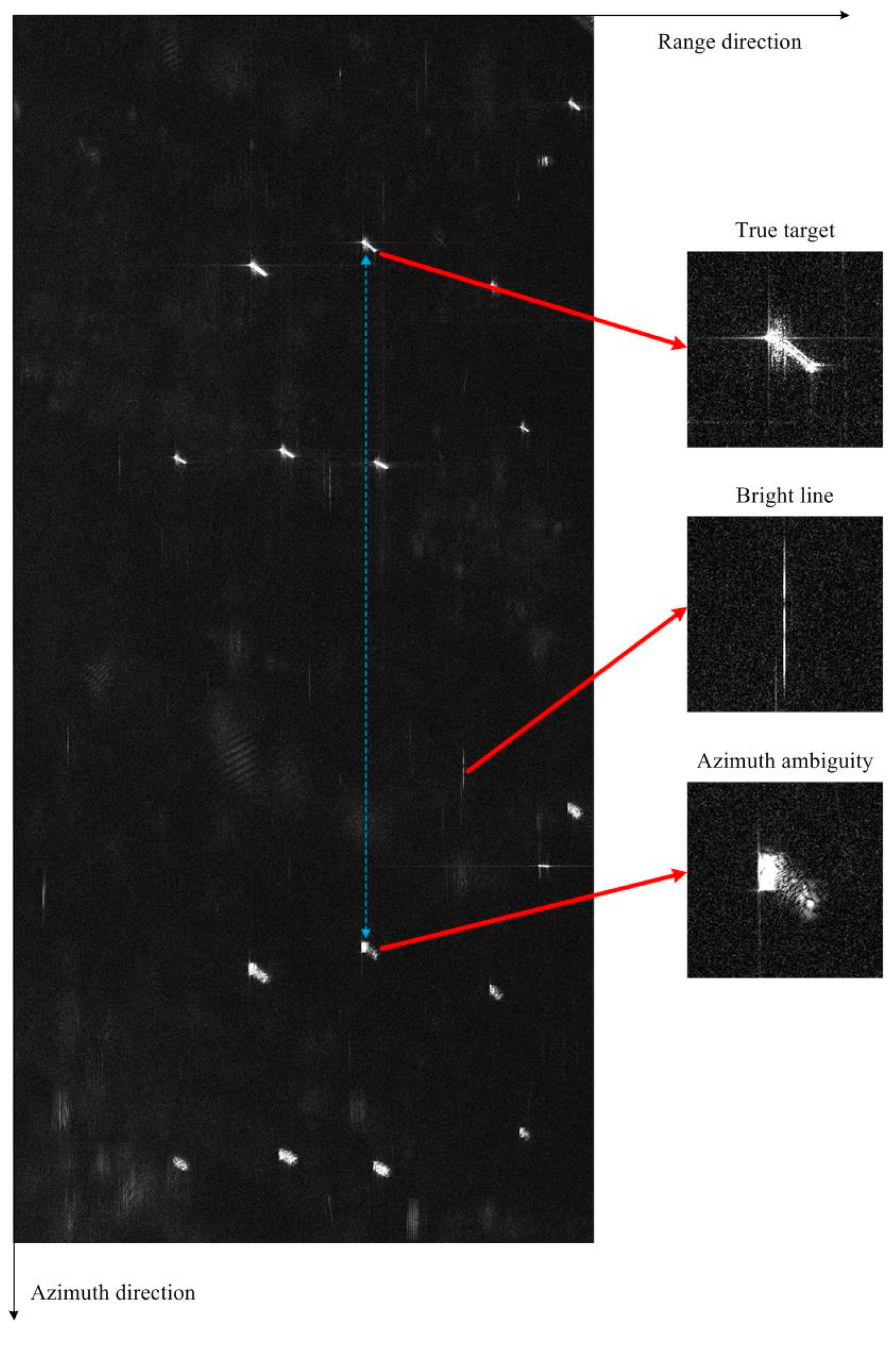
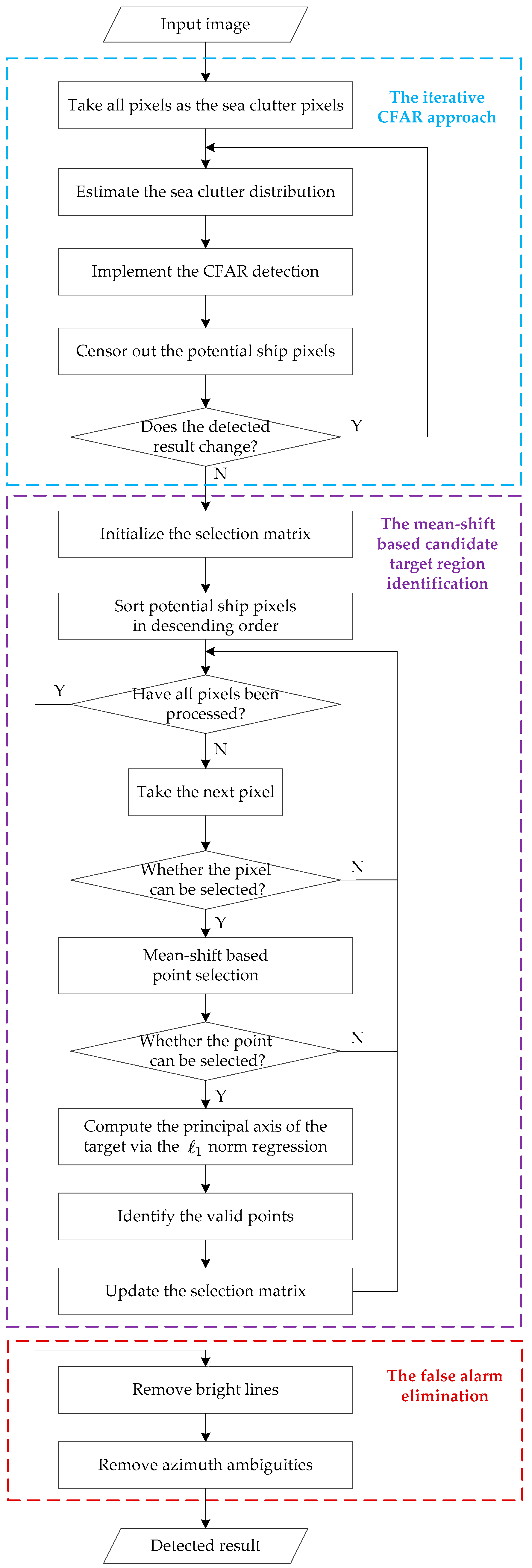
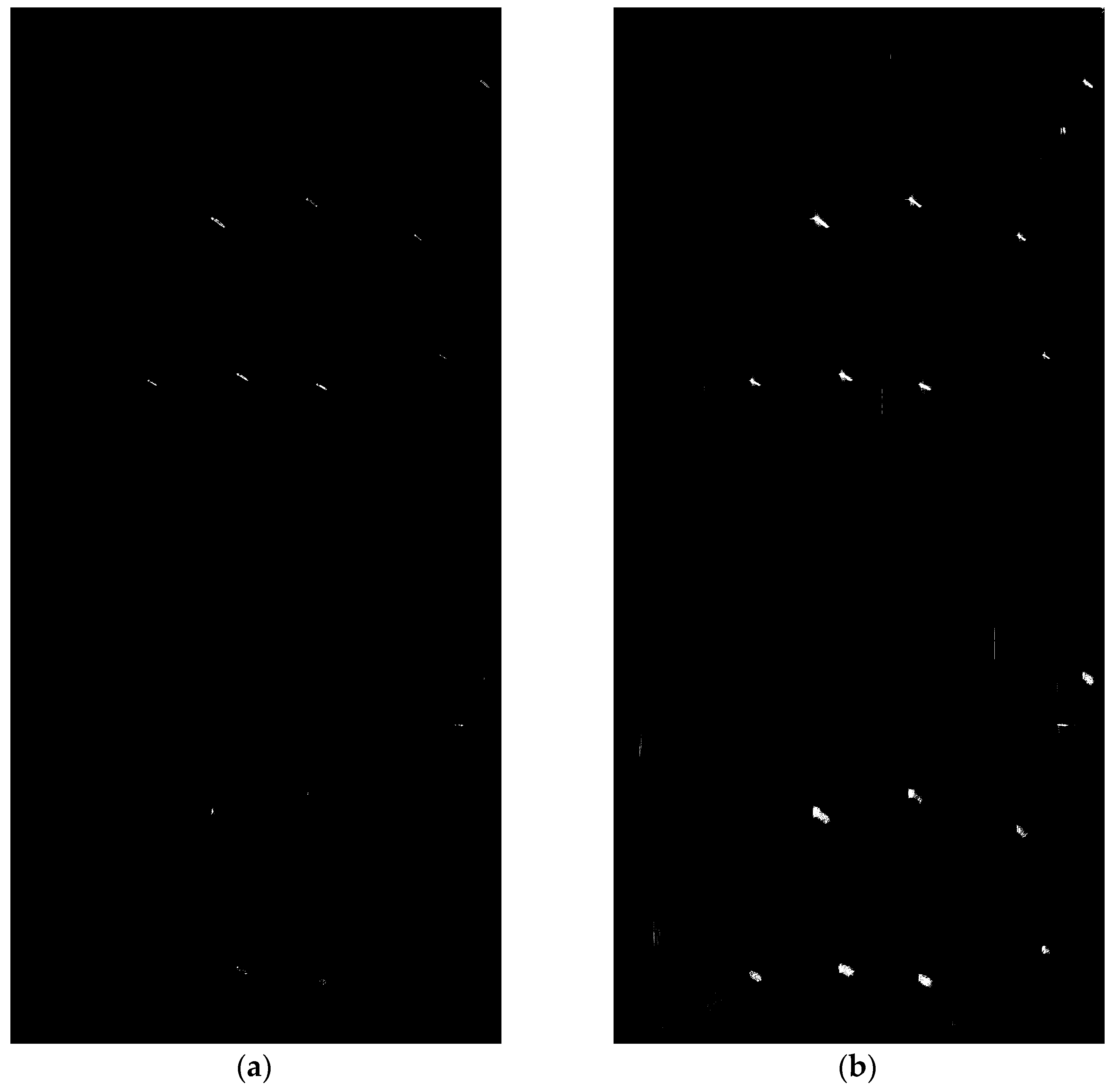
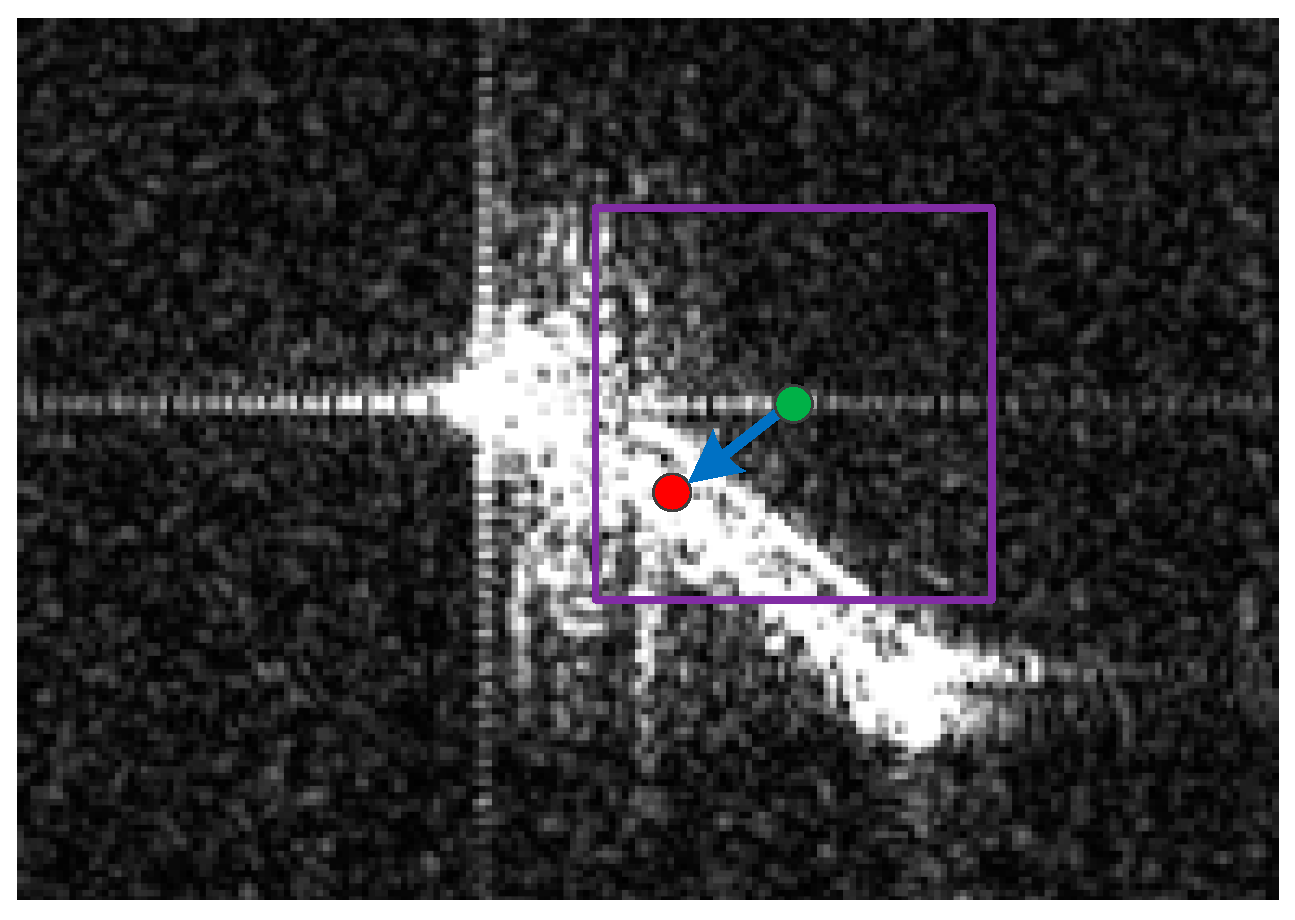


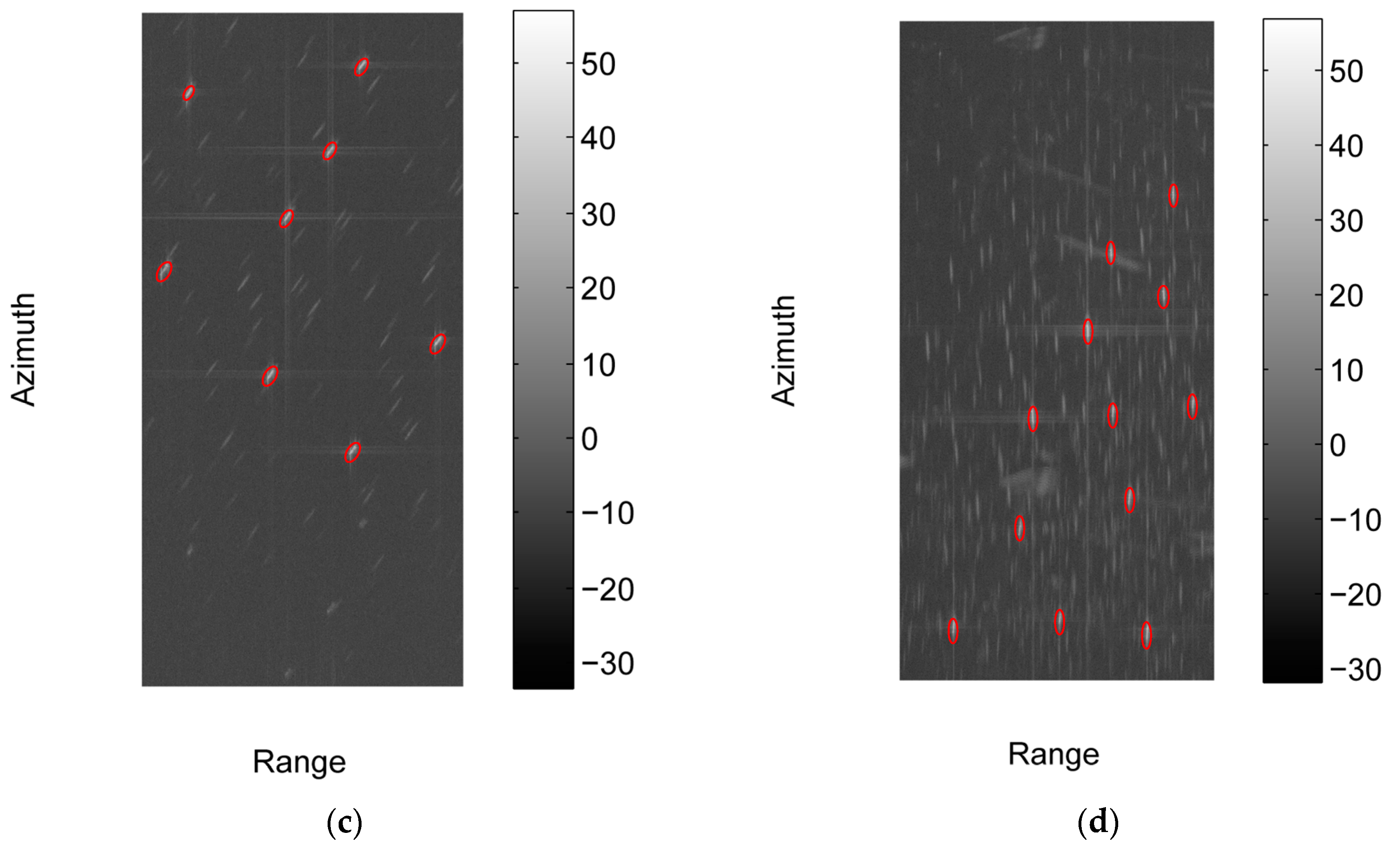
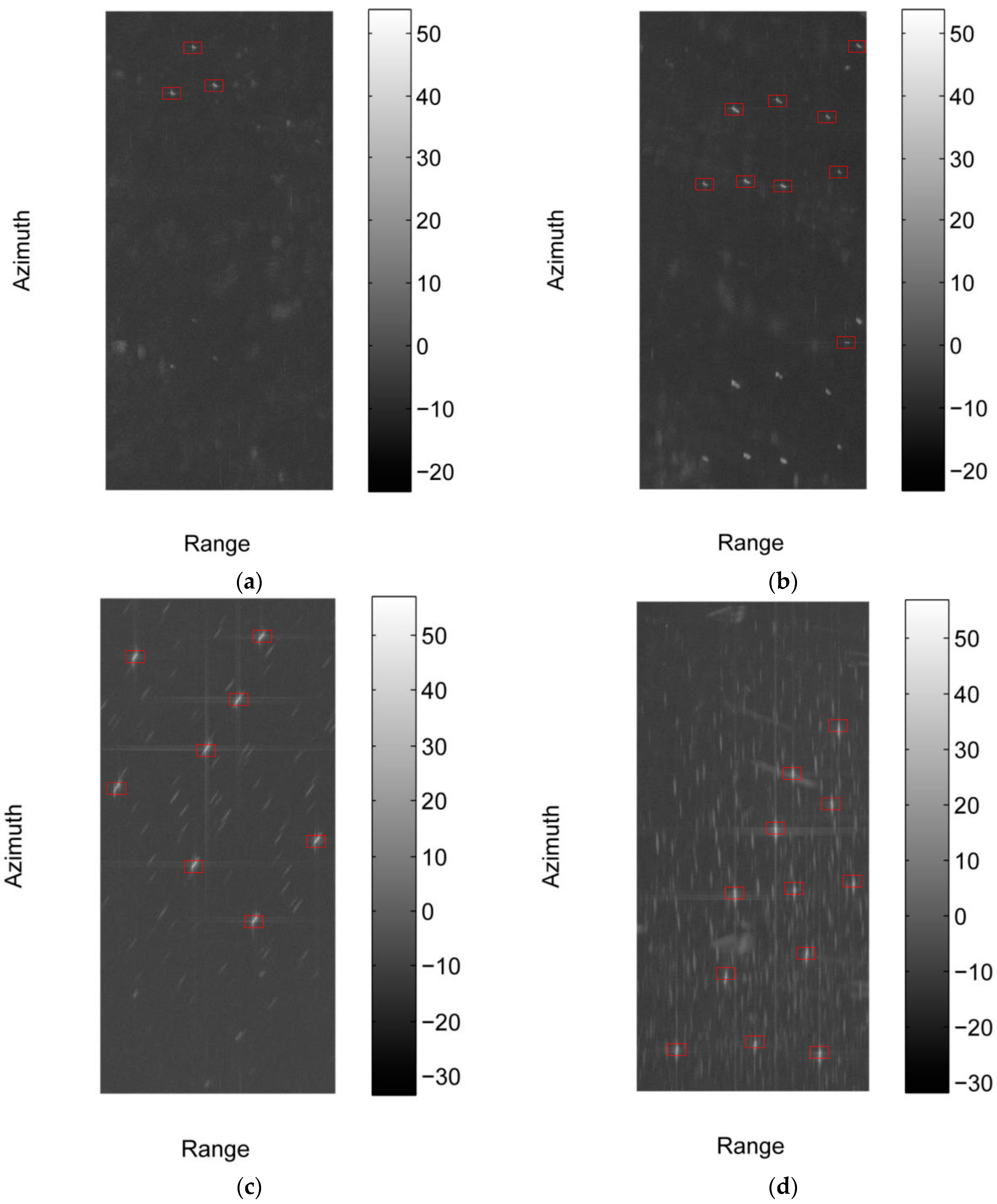
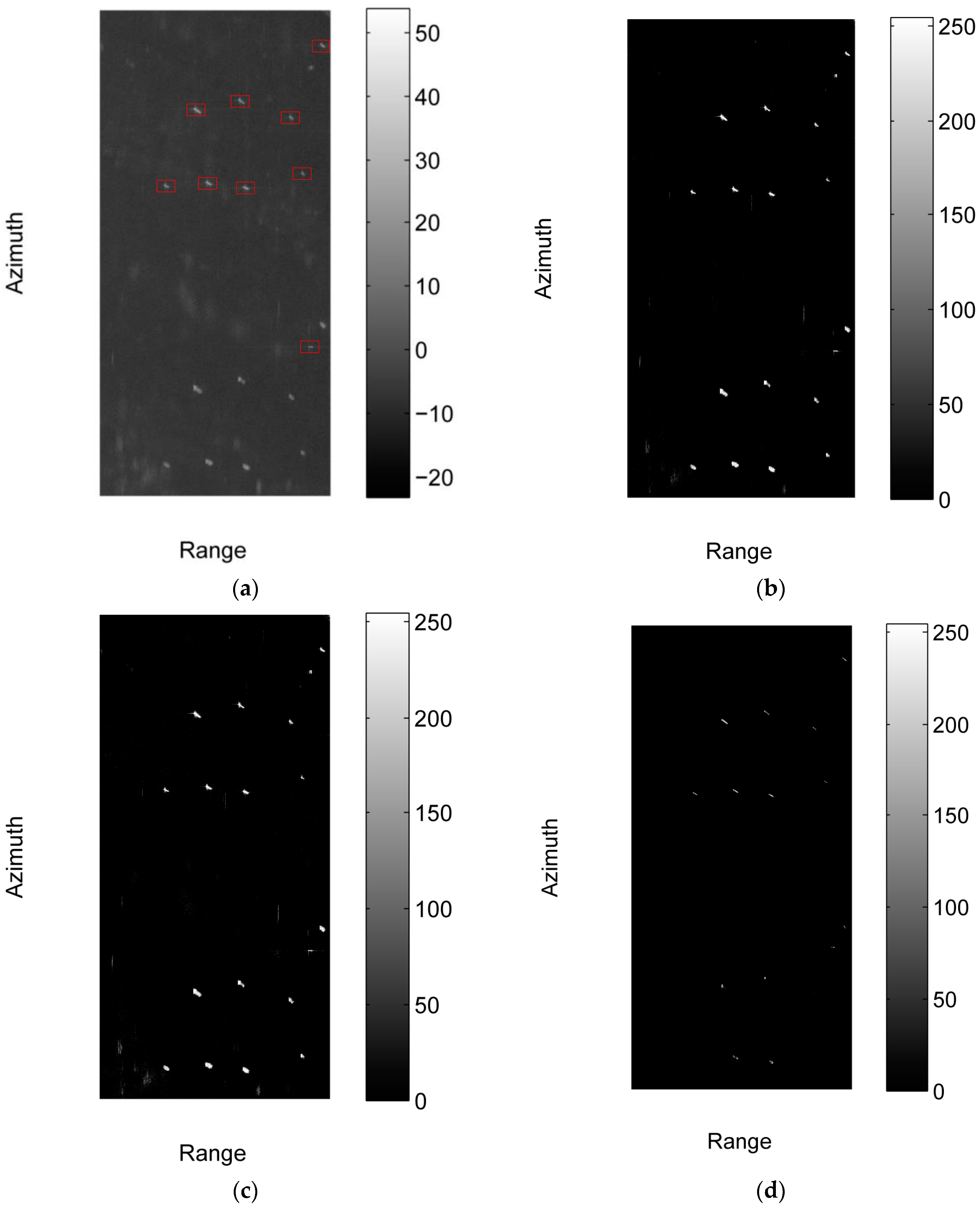
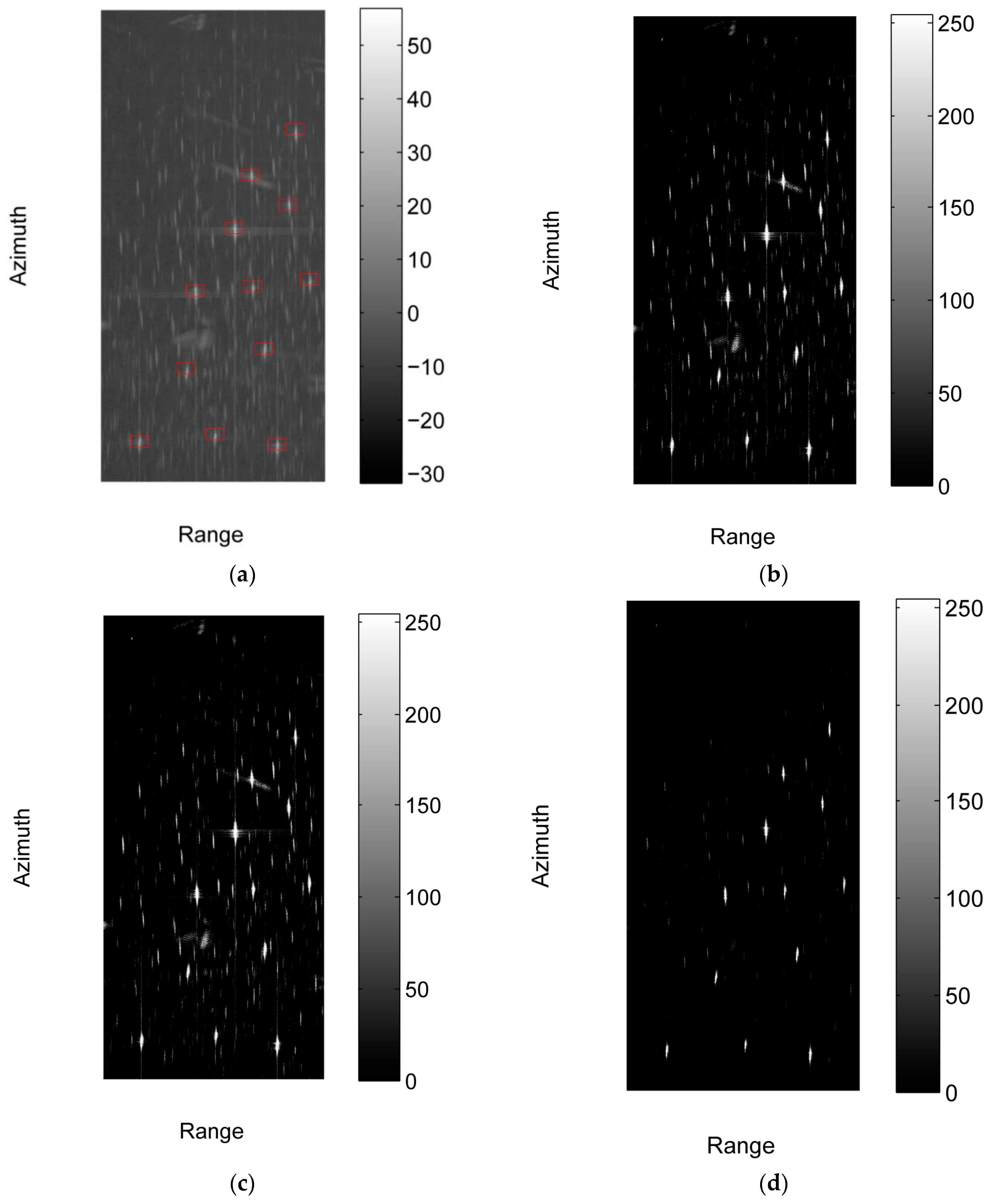
| Parameter | Image #1 | Image #2 | Image #3 |
|---|---|---|---|
| Region | East China sea | Bohai sea | Bohai sea |
| Imaging mode | UFS | UFS | UFS |
| Nominal resolution (m) | 3 | 3 | 3 |
| Resolution [Rng × Az] (m) | 3.3 × 2.4 | 3.3 × 2.4 | 3.3 × 2.4 |
| Number of looks [Rng × Az] | 1 × 1 | 1 × 1 | 1 × 1 |
| Wave length (m) | 0.0555 | 0.0555 | 0.0555 |
| Satellite direction | Descending | Descending | Descending |
| Look direction | Right | Right | Right |
| Polarization | DH | DH | DH |
| Product level | 1 | 1 | 1 |
| Product type | SLP | SLP | SLP |
| Incidence angles (degree) | 43.75–45.29 | 48.53–49.79 | 48.51–49.80 |
| Size [Rng × Az] (pixel) | 20316 × 20207 | 19,443 × 21,643 | 19,905 × 21,640 |
| Pixel width [Rng × Az] (m) | 1.124 × 1.794 | 1.124 × 1.705 | 1.124 × 1.705 |
| Method | Sub-Image #1 | Sub-Image #2 | Sub-Image #3 | Sub-Image #4 |
|---|---|---|---|---|
| TS-SEG-CFAR | 100.783 | 102.096 | 101.261 | 101.646 |
| IICS | 43.683 | 43.972 | 43.873 | 43.795 |
| SLIC-CFAR | 1091.410 | 1094.040 | 1095.644 | 1094.261 |
| Our method | 3.759 | 3.354 | 3.510 | 3.525 |
© 2017 by the authors. Licensee MDPI, Basel, Switzerland. This article is an open access article distributed under the terms and conditions of the Creative Commons Attribution (CC BY) license (http://creativecommons.org/licenses/by/4.0/).
Share and Cite
Pan, Z.; Liu, L.; Qiu, X.; Lei, B. Fast Vessel Detection in Gaofen-3 SAR Images with Ultrafine Strip-Map Mode. Sensors 2017, 17, 1578. https://doi.org/10.3390/s17071578
Pan Z, Liu L, Qiu X, Lei B. Fast Vessel Detection in Gaofen-3 SAR Images with Ultrafine Strip-Map Mode. Sensors. 2017; 17(7):1578. https://doi.org/10.3390/s17071578
Chicago/Turabian StylePan, Zongxu, Lei Liu, Xiaolan Qiu, and Bin Lei. 2017. "Fast Vessel Detection in Gaofen-3 SAR Images with Ultrafine Strip-Map Mode" Sensors 17, no. 7: 1578. https://doi.org/10.3390/s17071578
APA StylePan, Z., Liu, L., Qiu, X., & Lei, B. (2017). Fast Vessel Detection in Gaofen-3 SAR Images with Ultrafine Strip-Map Mode. Sensors, 17(7), 1578. https://doi.org/10.3390/s17071578






